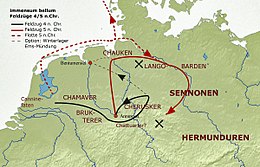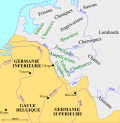Treva
Treva | |
|---|---|
| ". |
Treva is the historical name of a settlement during the short-lived creation of the Roman province of Germania, at the site of the modern city of Hamburg in Germany.
History
The Romans reached the
Some evidence indicates that they built a "marching camp" in a small island in the estuary of the river Elbe, in a place where their ships could arrive (and be protected by a small port) when sailing from

This place was called "Treva" and later probably had a small vicus populated by local Germans with some Roman merchants. The origin of the name is similar to the Latin name of Trier: tre from Latin "trans" (through) and va from German "var" (river).
Indeed
"Praeterea in tutelam provinciae praesidia atque custodias obique (Drusus) disposuit per Mosam flumen, per Albin, per Visurgim" (in order to defend and control the Germania province, Drusus established forts along the river Meuse, Elbe, Weser). Florus, "Epitomae" of Roman History [2]
So, after Drusus, Ahenobarbus penetrated further into the country than any of his predecessors had done.[3] Furthermore, the future emperor Tiberius campaigned extensively while in Germany, even conducting some amphibious operations along the Elbe River in 5 AD and probably landing also in the surroundings of Treva.[4]

Later,
The actual name Hamburg comes from the first permanent building on the site, a
The Hammaburg, conveniently situated on the river Alster, Elbe and Bille, was from the beginning a trading place...the original Hamburgers were traders....The wooden burgeon sheltered by a moat and palisades lay on a land that was surrounded north, west, and south of the meandering Alster...In the 1980s, a "double circuit" was found, the remains of an early medieval fortification. Until now it had been assumed that it dates back to the 6th century or earlier (some even spoke of stone age).Die Welt[7]
Recent archaeological discoveries in the center of Hamburg have proved the existence of a trade settlement during Roman times. Furthermore, some gold roman coins have been discovered in Lokstedt (a section of Hamburg).[8]
See also
Notes
- ^ Die Grossprovinz Germanien: idea e forma di macroprovincia augustea, by Davide Faoro (University of Trento)
- ^ Epitomae- liber secundus XXX
- ^ Tacitus, The Annals 4.44
- ^ Nolan Doyle; p. 12
- ^ Treva
- ^ Map of Tacitus cartography, with Treva along other ancient localities
- ^ Die Welt: Sensation
- ^ Michelle Kossel. Als Geld die Welt zu regieren begann ([1])
Bibliography
- Doyle, Nolan. The Pannonian Revolt, Teutoburg Forest and the Formation of Roman Frontiers. Senior Seminar: HST 499 Professor B.H.Hshieh. Western Oregon University June 15, 2007 ([2])
- F. Langewiesche: Germanische Siedlungen im nordwestlichen Deutschland zwischen Rhein und Weser nach dem Berichte des Ptolemäus. Beilage zum Jahresbericht des Realprogymnasiums zu Bünde über das Schuljahr 1909/10.
- Kleineberg Andrea, Christian Marx, ISBN 978-3-534-23757-9.
- J.-M.A.W.Morel. The early roman harbours. Velsen, in: R.W.Brandt, W.Groenman-van Waateringe & S.E.van der Leeuw (eds.), Assendelver Polder Papers 1, Amsterdam 1987, pags. 169–175.
- Powell, Lindsay (2011). Eager for Glory: The Untold Story of Drusus the Elder, Conqueror of Germania. Barnsley, South Yorkshire: Pen & Sword Books. ISBN 978-1-84884-333-2.
- Tacitus. Annals (Tacitus, Annals, I–VI, English translation)

